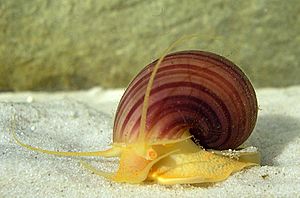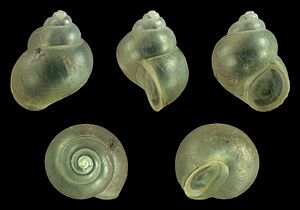Pomacea bridgesii facts for kids
Quick facts for kids Pomacea bridgesii |
|
|---|---|
 |
|
| Pomacea bridgesii in aquarium | |
| Conservation status | |
| Scientific classification | |
| Kingdom: | |
| Phylum: | |
| Class: | |
| Subclass: |
Caenogastropoda
|
| (unranked): |
Architaenioglossa
|
| Superfamily: |
Ampullarioidea
|
| Family: | |
| Genus: |
Pomacea
|
| Subgenus: |
Pomacea
|
| Species: |
P. bridgesii
|
| Binomial name | |
| Pomacea bridgesii (Reeve, 1856)
|
|
The Pomacea bridgesii, often called the spike-topped apple snail or mystery snail, is a type of freshwater snail. These snails come from South America. They are special because they have both gills, like fish, and an operculum, which is like a little trapdoor on their shell. Mystery snails are aquatic gastropod mollusks and belong to the family Ampullariidae. They likely came to the United States because people bought them for their home aquariums.
Contents
Amazing Snail Body Parts
Mystery snails have special eyes located at the end of stalks on their head. What's really cool is that they can regrow their eyes completely if they get damaged!
These snails are born with both gills and lungs. This means they can breathe underwater using their gills, and they can also breathe air from above the water using their lungs. They also have a small tube called a siphon. They often use this siphon to reach the surface and take a breath of fresh air.
Where Do Mystery Snails Live?
Mystery snails originally come from countries in South America. You can find them naturally in places like Bolivia, Brazil, Paraguay, and Peru.
Mystery Snails in New Places
Sometimes, mystery snails end up in places where they don't naturally live. This often happens because of the aquarium trade. For example, they have been found in Hawaii since 1960. They also appeared in Southeast Asia in the 1980s and in Florida around the same time.
Life Cycle and Reproduction
Most mystery snails lay their eggs above the water line. This keeps the eggs safe from fish that might want to eat them. To have babies, you need both a male and a female snail, as they are gonochoristic.
After the eggs are laid, it takes about 2 to 4 weeks for them to hatch. A single snail can lay up to 200 eggs at one time! However, not all of them will hatch, as some eggs might not be fertilized.
When the tiny snails hatch, they are very small. They can grow super fast if they get enough food and calcium. A baby snail can grow from a tiny speck to the size of a pea in just over a week! In about two months, with the right food, a mystery snail can grow to be almost the size of a golf ball. At this size, they are ready to have their own babies.
Their Environment
Mystery snails often live in lakes or rivers where there might not be a lot of oxygen in the water. Luckily, they are well-equipped for this! They have both an air tube (siphon) and a lung, as well as a gill. This allows them to easily breathe and get the oxygen they need to survive.
Pomacea bridgesii snails prefer warm, tropical places. They cannot survive in water that is colder than about 50 degrees Fahrenheit (10 degrees Celsius).
See also
- Algae eater



